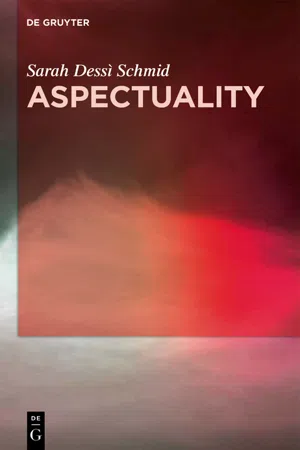1.1 Introductory remarks
It has become commonplace to introduce works on aspect with the remark that there is hardly another field in linguistics so much plagued by terminological and notional confusion. The semantics of time has served as a playground for mental exercise to many generations of philologists, linguists, philosophers, and logicians, resulting in an impenetrable thicket of definitions, theories, and models.
(Sasse 2002, 199)
It is not easy to resist the temptation to deal with time, which is one of the fundamental categories of human cognition and one of the most important structuring principles of our individual as well as social life. It is therefore not surprising that generations of physicists, philosophers, historians, logicians, literati and linguists have yielded to this urge. It is in concession to this fact, indicated in the quote above, that I begin this work and enter the fascinating “impenetrable” terminological thicket.
A distinction is to be made between, on the one hand, physically or publicly and psychically or personally constructed time, which can be conceived of as objectively measurable and subjectively perceivable, and, on the other hand, time in language, in other words, the linguistic representation of temporal conditions. These conditions are represented by various means – both lexical and grammatical – in every language at different organisational levels, both morphological and syntactic. This includes the verbal categories “tense”, “aspect” and “Aktionsart”.
In this chapter, the traditional definitions of tense, aspect and Aktionsart are given as verbal categories by which individual languages provide information about the temporal structuring of states of affairs. Each of these categories is presented by means of various hermeneutic models, which are important not just for the Romance languages. The brief overview of the current state of research that I give here is – for a number of reasons – only very selective and regards the specific topics of this book. On the one hand, a more detailed historiographical account of these models is beyond the scope of this study and contradicts its approach. On the other hand, an exhaustive treatment of the literature devoted to the categories of the verbal system in recent decades would in itself constitute an endeavour doomed to failure: in his bibliographical project, The Project on Annotated Bibliography of Contemporary Research in Tense, Grammatical Aspect, Aktionsart, and Related Areas, Binnick counts no less than 9,000 titles – and the last update of the bibliography was in 2006. The chapter will close with a brief discussion of the delimitation problems of the traditionally perceived categories of tense, aspect and Aktionsart, which will form a bridge to the following chapter.
1.2 Tense, aspect and Aktionsart – traditional definitions
1.2.1 Tense – a grammatical, deictic category
Let us consider the following examples:1
(1a) | It. | Leo mangia [Pres.] un cornetto al cioccolato. |
(1b) | Fr. | Léo mange [Prés.] un croissant au chocolat. |
(1c) | Sp. | Leo come [Pres.] un cruasán con chocolate. |
(1d) | Ger. | Leo isst [Präs.] ein Schokocroissant. |
| ‘Leo eats a chocolate croissant.’ |
(2a) | It. | Leo mangiò [Perf. Sem.] un cornetto al cioccolato. |
(2b) | Fr. | Léo mangea [Pass. Sim.] un croissant au chocolat. |
(2c) | Sp. | Leo comió [Perf. Sim.] un cruasán con chocolate. |
(2d) | Ger. | Leo aß [Prät.] ein Schokocroissant. |
| ‘Leo ate a chocolate croissant.’ |
(3a) | It. | Leo mangiava [Imp.] un cornetto al cioccolato. |
(3b) | Fr. | Léo mangeait [Imp.] un croissant au chocolat. |
(3c) | Sp. | Leo comía [Imp.] un cruasán con chocolate. |
(3d) | Ger. (= 2d) | Leo aß [Prät.] ein Schokocroissant. |
| ‘Leo was eating a chocolate croissant.’ |
(4a) | It. | Leo mangerà [Fut.] un cornetto al cioccolato. |
(4b) | Fr. | Léo mangera [Fut.] un croissant au chocolat. |
(4c) | Sp. | Leo comerá [Fut.] un cruasán con chocolate. |
(4d) | Ger. | Leo wird [Fut.] ein Schokocroissant essen. |
| ‘Leo will ea... |
